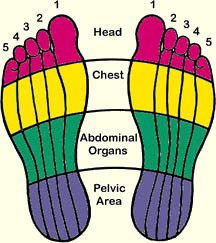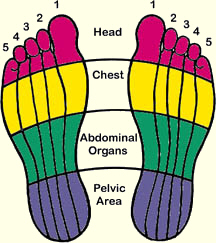Reflexology Case Study


Reflexology Case study example
This case study is helpful for those or anyone studying reflexology as a beginner or experienced reflexology therapist.
Client is a 28 year old female; she is married with a 2 year old child. Her husband works on the Oil rigs and is away a great deal of the time. Myclient runs an internet business and works from home, also taking care of her daughter full time as she does not go to any nursery at this time.
She is overweight and a member of a well-known slimming club. She finds sticking to the diet hard at times and can become depressed with the slow process. Her main fluid is diet coke and coffee, water intake is almost nil. She eats salad the majority of time but no fruit. Her exercise regime is almost nonexistent.
She has a history of anxiety and panic attacks, she has taken medication for this condition for some time approx. 4 years on and off and wants to begin to reduce the dosage and get of them completely within the next 6-9 months. In addition to the anxiety she suffers tension headaches and some side-effects of the anti-anxiety medication; dry mouth, lethargy and headaches.
Her stress is described as low at the moment and her sleep pattern much improved now her daughter is sleeping through the night these past few months.
Current issue for seeking help
My client wants to feel healthier, relaxed and improve her energy levels.
Treatment Plan
I advised making some changes to her diet such as reducing her coke and coffee consumption and increase her fluid or fruit tea consumption considerably. I suggested making an increase in her vegetable intake in such a way to increase the vitamin and minerals she could benefit from. I suggested that she would benefit from a good multi-vitamin if she was not already doing so.
As she does very little exercise I advised her that going for a walk and increasing what she did would not only speed up weight loss, it would help with energy levels and her anxiety. If she joined exercise classes she would meet more people feel, less isolated, be more motivated and deal with anxiety.
With regard to the reduction of her medication I strongly advised that she did not cut out the medication rapidly and that she should do it very slowly and talk to her GP or pharmacist for the optimal way to go about doing this.
We agreed that she would have weekly treatments for the next 6 weeks and we would assess again then. I want to ensure that S feels relaxed and that we can reduce her anxiety levels. I want my main focus to be the reflexes that deal with the hypothalamus gland, solar plexus, adrenal glands, eyes, head and sinus’.
Treatment
Before the arrival of client I had already made sure that the room was tranquil and encouraged relaxation. In preference to what I had learnt in the consultation I choose to use rose oil in my oil burner, rose is particularity good I have found to promote relaxation when used with anxious clients. S said she was cold, even though the room had heating on quite high but I provided her with a blanket for added comfort.
Initially I used a foot bath to warm her feet and encourage relaxation. I used a footbath with stones and added a mix of dried Thyme, Rosemary and lemon for their uplifting and calming qualities. The scent is not over strong when dried and used in a footbath. S preferred not to use powder for her massage so instead I choose a grape seed oil cream mixed with a small amount of Rose and Lavender oil. Again choosing these for their calming, anti-anxiety and relaxation properties. After the foot bath I dried S’s feet and using a towel that had been warmed I wrapped her foot not being massaged in it to increase her comfort.
Her feet were cold to touch, which suggests poor circulation but apart from that her feet looked to have no other issues, a sign of healthy feet.
As I have already discussed the reflex points and massage techniques adopted in the previous case study in the general initial treatment for the ease of reading I will make a note of the general sequence and go into detail about the additional reflexes and massage used in this case study.
During this session I used a number of massage techniques that included walking, circles, hooking and rocking the feet with my hands. When working on one foot it was always supported with my “free” hand either at the heel or around the toe area.
To begin with, after the foot bath, I set out to relax the feet. I begin with the right foot first and then do the same or equivalent on the left foot. I relax the feet to begin with right then left and return to the right foot to give a general treatment and then do the left. In this case study I did the initial treatment and focused on the stress/anxiety reflexes, I will include what I did extra at the end of the general treatment sequence for ease of reading.
Relaxing the feet sequence approx. 8 minutes Starting with the solar plexus I did the inner breathing followed by (in this order) Angel’s touch; Apollo’s breath; Atlas’s Orb; Poseidon’s Pull; Healing Tornado; Toe Rotation; Hermes Stretch and finishing with Phoenix Rising.
General or Basic reflexology treatment sequence approx. 40 minutes
The following reflex points were treated in this order using a number of massage techniques which I describe in full in my previous case study. I have grouped them in systems.
- A) Head; Brain; Teeth and Jaw; Occipital; Inner Ear; Sinus; General Eye and Ear; Eye; Eustachian Tube; Outer Ear.
B) Shoulders; Diaphragm
C) Thyroid; Pituitary; Hypothalamus; Parathyroid;
D) Oesophagus; Lung; Stomach; Hiatus Hernia; Pancreas; Gall Bladder (Right foot only); Liver (Right foot only); Spleen (Left foot only);
E) Sciatic; Appendix (Right foot only); Ileocaecal (Right foot only); Ascending Colon (Right only); Hepatic Flexure (Right foot only); Transverse Colon.
F) Sigmoid (Left foot only); Sigmoid Flexure (Left only); Descending Colon (Left only); Splenic Flexure (Left only), Transverse Colon.
G) Uterus; Groin Lymphatics; Ovaries; Fallopian Tubes;
H) Calf muscle massage
I) Rectum;
J) Wrists; Elbows; Knees and Hips.
K) Lower back; Bladder; Ureter; Kidney’s
L) Cervical Vertebrae; Thoracic Vertebrae; Lumber Vertebrae; Coccyx.
M) Upper Lymphatics; breasts
For the sequence relating to de-stressing my client I did the following sequence of massage:
- • At the diaphragm flexing the foot to create tension and using my thumb to work under the metatarsal head going from lateral to medial using slow steps and repeating 8 times. (both feet)
• At the Thyroid reflex point I used my thumb to massage the ball of the foot, from the diaphragm to the neckline in a slow and steady manner. I repeated this 6 times. The thyroid is what regulates energy levels and so focusing on this point can help to with energy levels and an optimal working thyroid. (both feet)
• Pituitary reflex point I found the centre of the big toe and using my thumb to put pressure, pushing in and making small circles for approx. 15 seconds (Both feet)
• With the Pancreas Reflex point, which is the right foot only, pushing up into the joint where the reflex is found (below 3rd toe lower than the diaphragm) and for approx. 15 seconds made small circles.
• With the kidneys using my thumbs together I gently pushed into the reflex point and again made small circles for around 15 seconds. (Both feet)I finished this sequence with working the entire spinal reflexes to help reduce the tension and stress. I made 7 tiny steps along the big toe; 12 steps along the foot to the navicular bone working the entire thoracic vertebrae. I repeated this three more times. (Both Feet), I also completed the massage with Toe Rotation adn the inner breathing technique.
Evaluation
To finish the treatment I gave my client aftercare advice about the necessity of drinking plenty of fluid to help flush out the toxins, try to remain calm and relaxed and to be aware of a healing crisis. I also reiterated what we had discussed prior to the treatment regarding diet, exercise and fluid intake along with the increase in vitamins and minerals and the discussion with the relevant health care worker about the anti-anxiety medication.
During the treatment I was aware of popping at the head, shoulder, thyroid and small intestine reflexes this would suggest to me that S had imbalances at these areas.
I also felt crystals at the Ureter which would be in correlation with dehydration and a lack of water intake.
There was also some popping at the ovary reflex and when questioned I learnt that S suffers from PMS regularly and she was coming up to that point in her cycle. I advised her about eating plenty of vegetables and fruit, increasing water and trying to keep her liver as free from toxins as possible to help regulate her hormones.
Her feet were much warmer at the end of the treatment and the circulation looked much improved. I made notes on my discoveries to help with further treatments.
For the next treatment I plan to focus on relaxation, decreasing her anxiety levels and working on the areas with the imbalances, unless she presents with any other requests at the next treatment session.
At the end of the treatment she felt much calmer, de-stressed and fully relaxed. She had never had reflexology before but found it a pleasant and comforting experience. She agreed to look into exercise classes in the area, increase her water intake and look into the multi vitamin options available to her and take some. She would think about talking to her GP about her medication but finds her GP to be unhelpful and abrupt. I told her there was no rush and maybe try an appointment with another GP at her practice or a pharmacist who under new guideline and prescribing legislation can offer advice on prescription drugs. All patients on long term drugs should always be involved in drug reviews every 12 months according to government guidelines.
LEARN REFLEXOLOGY – Accredited Diploma Course
Post views: 13830